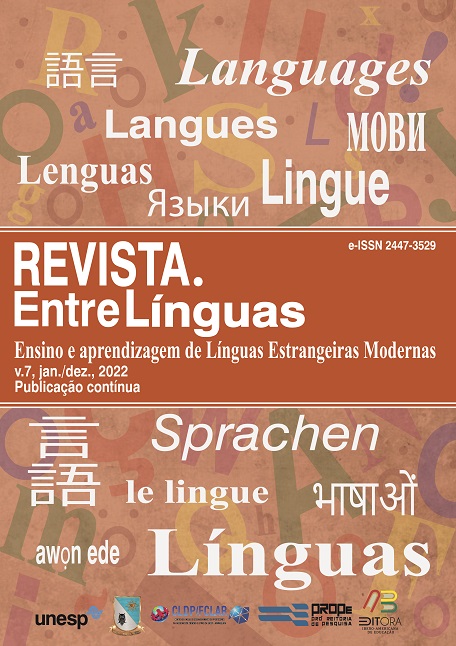O papel da tradução de linhas no estudo e ensino da camada lexical das línguas turcas
DOI:
https://doi.org/10.29051/el.v8i00.17676Palavras-chave:
Ensinando e aprendendo, Línguas turcas, Vocabulário e tradução de linhasResumo
No processo de estudo abrangente da camada lexical moderna das línguas turcas, pesquisa fundamental de palavras de origem turca, é importante olhar para o quadro histórico do léxico. Juntamente com os materiais disponíveis sobre o antigo período turco, os monumentos escritos da Idade Média e da Nova Era devem ser estudados de forma síncrona e diacrônica. A mudança na forma de pensar e na formação da visão de mundo dos turcos, que cultuavam diversas religiões e crenças, não poderia deixar de afetar sua linguagem. Durante séculos, fatores que influenciaram a vida, estilo de vida, cultura e pensamento dos turcos levaram ao surgimento de novos lexemas na língua, o uso de equivalentes e sinônimos de lexemas na língua para mostrar nuances semânticas. O estudo dessas palavras cronologicamente em textos escritos ajuda não apenas a estudar o léxico das línguas turcas, mas também a determinar a capacidade dos turcos de criar novas palavras, sua maneira de pensar.
Downloads
Referências
ADL. Dialectological dictionary of the Azerbaijani language. Baku: East-West, 2007.
ATA, A. Nehcü'l Ferâdîs. Uştmahlarnınˆg Open Way. The Open Way to Heaven. III Dictionary, Turkish Language Institution Publications. Ankara: TDK broadcasts, 1998.
ATA, A. The first translation of the Qur'an in Karahanlı Turkish (Rylands copy, introduction-text-notes-directory). Ankara: Turkish Language Institutions Publications, 2013.
BOROVKOV, A. K. Vocabulary sredneaziatskoqo tefsira. XII-XIII vv. Moscow: Izdatelstvo Vostochnoy Literature, 1963.
DANKOFF, R.; KELLY, J. Mahmud el-Kashgari Divanu Lugatiꞌt-turk. Istanbul: Kabalcı Publishing House, 2007.
HAMİDULLAH, M. Turkish Writing Translations of the Holy Quran. Turkish Journal XIV, 1964.
JAFEROĞLU, A. Old Uyghur Turkish Dictionary. Istanbul: TDK Broadcasts, 1968.
MURTAZİN, M. F. Koranovedeniye. Moscow: Izdatelstvo Moskovskiy Islamic University, 2010.
OYA. Orkhon-Yenisey monuments. Baku, 1993.
SAGOL, G. An inter-linear translation of the Qur'an into Khwarazm Turkish. Introduction. Text. Glossary and Facsimile. Introduction and text. Harvard, 1993. pt. I.
TOGAN, Z. V. Quran and Turks. Istanbul: Kayi Yayınları, 1971.
USHENMEZ, E. Karahanlı Turkish Dictionary. High School Thesis, Kütahya, 2006.
USHENMEZ, E. Line Between 1000 Annual Turkish Quran Translation. Istanbul: Academic Books, 2020.
Downloads
Publicado
Como Citar
Edição
Seção
Licença

Este trabalho está licenciado sob uma licença Creative Commons Attribution-NonCommercial-ShareAlike 4.0 International License.
Os manuscritos aceitos e publicados são de propriedade da Revista EntreLínguas. Os artigos publicados e as referências citadas na Revista EntreLínguas são de inteira responsabilidade de seus autores.
Transferência de direitos autorais – autorização para publicação
Caso o artigo submetido seja aprovado para publicação, já fica acordado que o(s) autor(es) autoriza(m) a UNESP a reproduzi-lo e publicá-lo na EntreLínguas, entendendo-se os termos “reprodução” e “publicação” conforme definição respectivamente dos incisos VI e I do artigo 5° da Lei 9610/98. O artigo poderá ser acessado pela rede mundial de computadores (Internet), sendo permitidas, a título gratuito, a consulta e a reprodução de exemplar do artigo para uso próprio de quem a consulta, desde que haja a citação ao texto consultado. Essa autorização de publicação 328 EntreLínguas, Araraquara, v. 1, n .2, p. 323-328, jul./dez. 2015 não tem limitação de tempo, ficando a UNESP responsável pela manutenção da identificação do(s) autor(es) do artigo. Os artigos publicados e as referências citadas na Revista EntreLínguas são de inteira responsabilidade de seus autores.











